| Article ID | Journal | Published Year | Pages | File Type |
|---|---|---|---|---|
| 5739607 | Fungal Biology | 2017 | 15 Pages |
Netto, M. S. B., Lima, W. G., Correia, K. C., da Silva, C. F. B., Thon, M., Martins, R. B., Miller, R. N. G., Michereff, S. J., and Câmara, M. P. S. 2016. Analysis of phylogeny, distribution, and pathogenicity of Botryosphaeriaceae species associated with gummosis of Anacardium in Brazil, with a new species of Lasiodiplodia. We identified Botryosphaeriaceae species associated with gummosis on Anacardium in Brazil. Isolates were sampled and identified on the basis morphology and phylogeny, through analysis of a partial translation elongation factor 1-α sequence, ribosomal DNA internal transcribed spacers, and β-tubulin gene sequence. Ten taxa were identified, namely, Lasiodiplodia brasiliense, L. euphorbicola, L. gonubiensis, L. iraniensis, L. jatrophicola, L. gravistriata sp. nov., L. pseudotheobromae, L. theobromae, Neofusicoccum batangarum, and Pseudofusicoccum stromaticum. Lasiodiplodia theobromae has been previously reported in cashew and is the most prevalent species observed. All the other species are reported here for the first time on this host. All species of Botryosphaeriaceae were pathogenic on detached green cashew shoots. Differences in aggressiveness were observed among the species, with N. batangarum, L. iraniensis, L. jatrophicola, and L. gravistriata characterized as the most aggressive species, whilst L. euphorbicola and L. pseudotheobromae were identified as the least aggressive.
